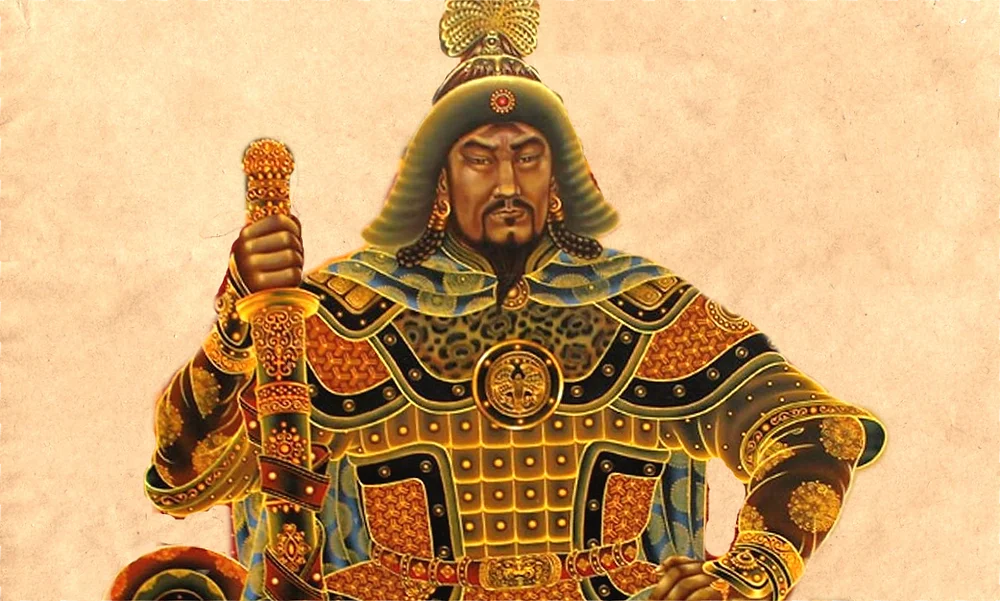The Ulus of Jochi is the land in the west of the Mongol Empire that Chinggis Khan granted to his eldest son, Jochi, in 1224. In turn, Jochi’s son Batu Khan conquered the Volga region, Russia, the Black Sea region, and the Caucasus for the Ulus, creating the largest state in medieval Europe. All the Kazakh khans can trace their ancestry back to Jochi’s descendants, and his ulus can rightly be considered the foundation of Kazakh statehood. This year, Kazakhstan celebrates the 800th anniversary of the Ulus of Jochi.
This is the first part of the history of the Jochi Ulus. The second part can be read here.
WHAT DO WE KNOW ABOUT JOCHI?
We do not know much about Chinggis Khan’s firstborn son. Born in the 1180s, he was apparently one of his father’s favorites and was considered his heir. At some point, Jochi’s successes began to make his brother Chagatai,1


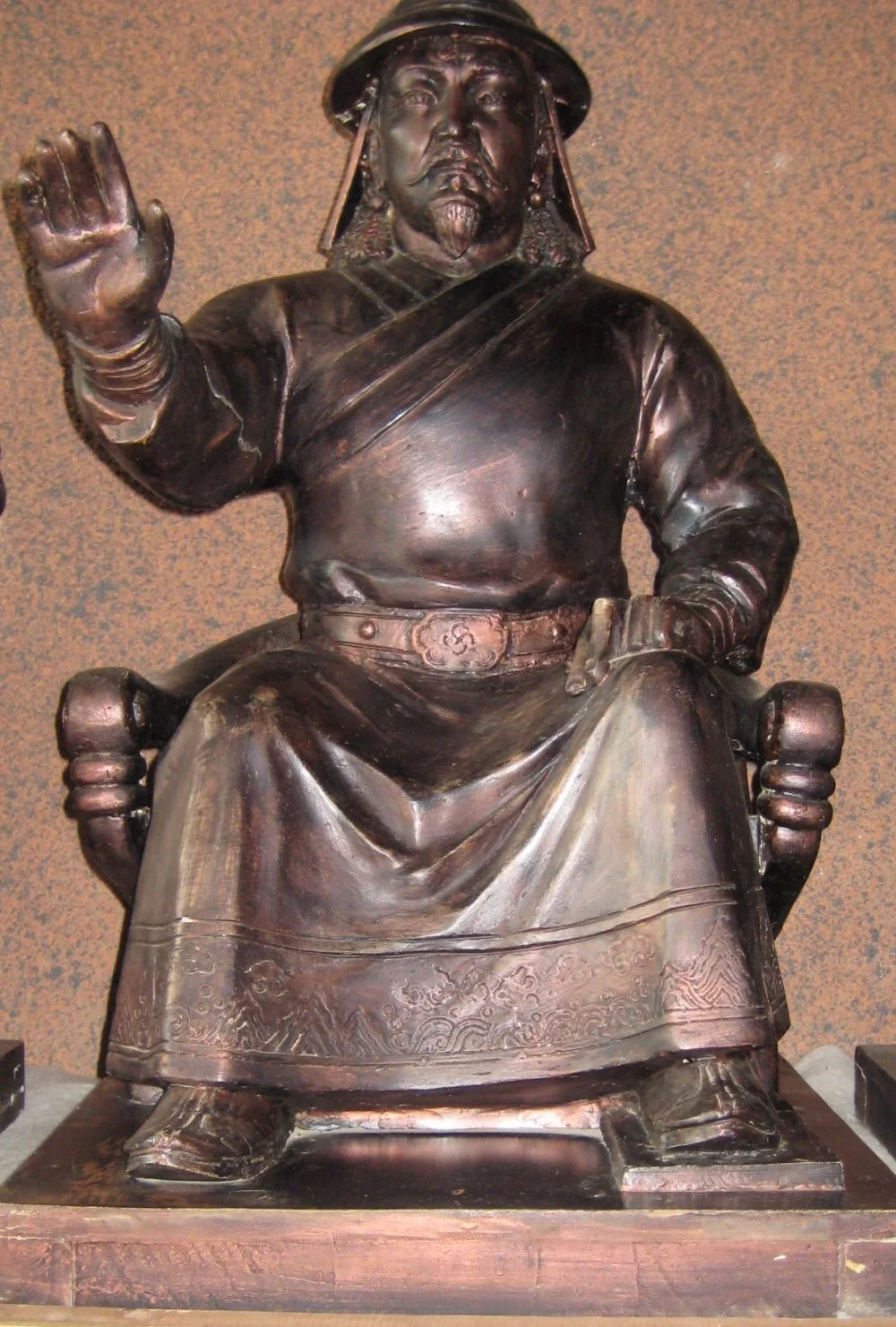
Juchi's statue in Mongol palace, Gachuurt Mongolia/Wikimedia commons
Nevertheless, Jochi held a very high status. The Persian historian Juwayni calls him Ulus-idi, the ruler of the ulus or the khan (in Mongolian, the word ‘uls’ means ‘state’). He is echoed by the Western traveler Plano Carpini, who calls Jochi kan, meaning ‘emperor’.
At first, the Ulus of Jochi occupied northern Khwarazm, Turkestan, and the eastern part of Dasht-i Qibchaq, which is present-day Kazakhstan. Most of these lands were conquered by troops under Jochi's command. For a long time it was thought that Jochi confined himself to this area, but it is now believed that he moved farther west. The Polish Franciscan monk Benedict Polak pointed out that Jochi crossed the Volga River and took part in the famous Battle of the Kalka River4
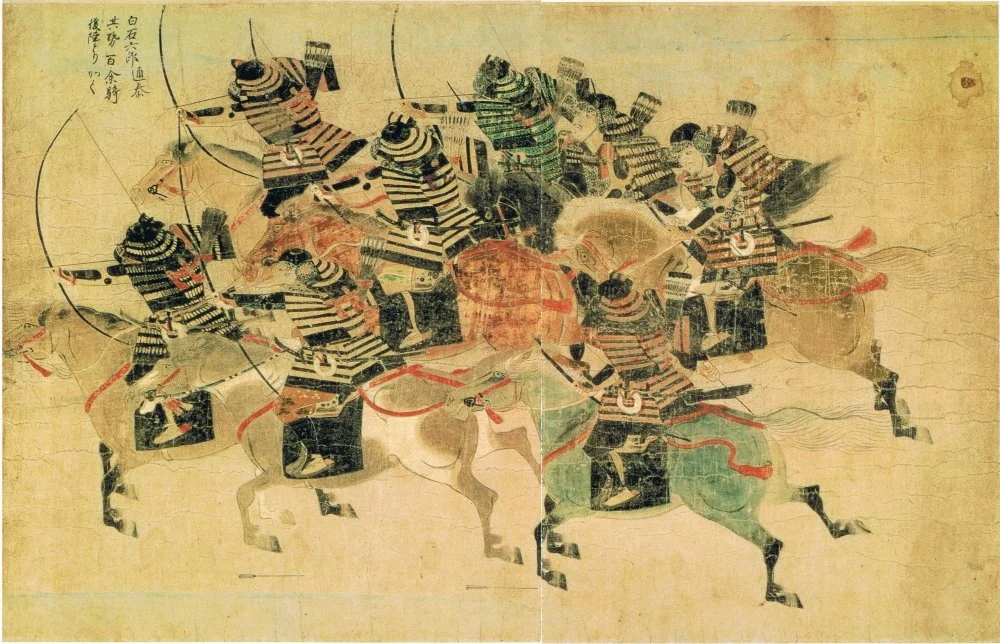
Japanese soldiers attack the Mongolian cavalry. Miniature from the Japanese "Scroll of the Mongol Invasion", 1293/Wikimedia commons
It is difficult to say what Jochi felt when he realized that the way to the top of the empire was closed to him. However, a Persian historian writes: ‘When Tushii
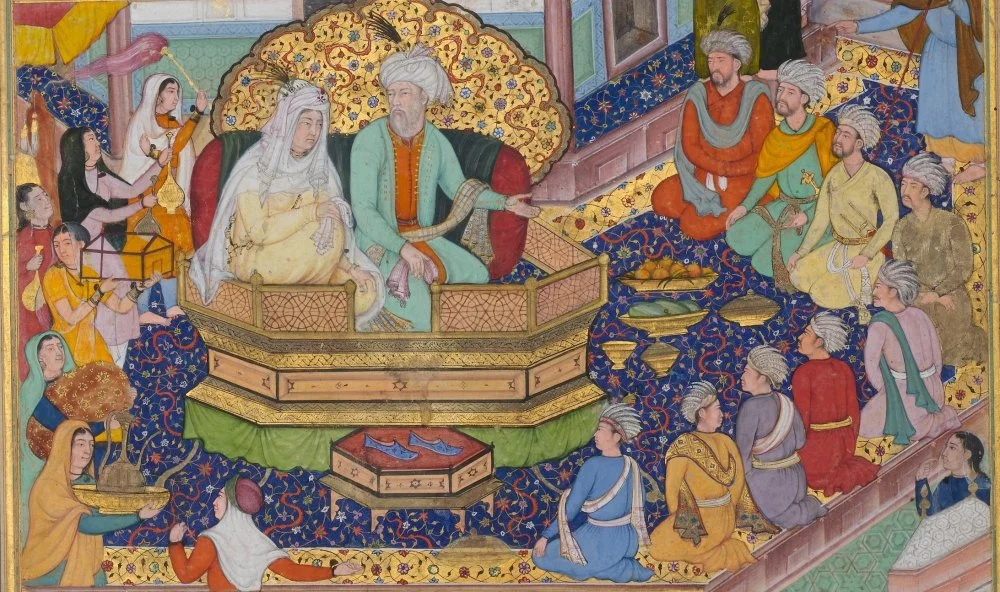
Genghis Khan, Borte and their sons. Miniature of the late 16th century/Wikimedia commons
Jochi died in 1225 or 1227 under mysterious circumstances. According to legend, he was hunting deer in the mountains and fell from his horse while shooting arrows, breaking his neck. But soon after Jochi's death, another version emerged that it was Chinggis Khan who ordered his son to be poisoned at Chagatai's suggestion. Allegedly, Jochi was preparing a plot against his father and wanted to kill him while hunting. The eighteenth-century Russian historian Vasily Tatishchev, who knew of many chronicles and documents that have not survived to the present day, claimed that Jochi died at Kalka in the battle with the Cumans and Russian princes.
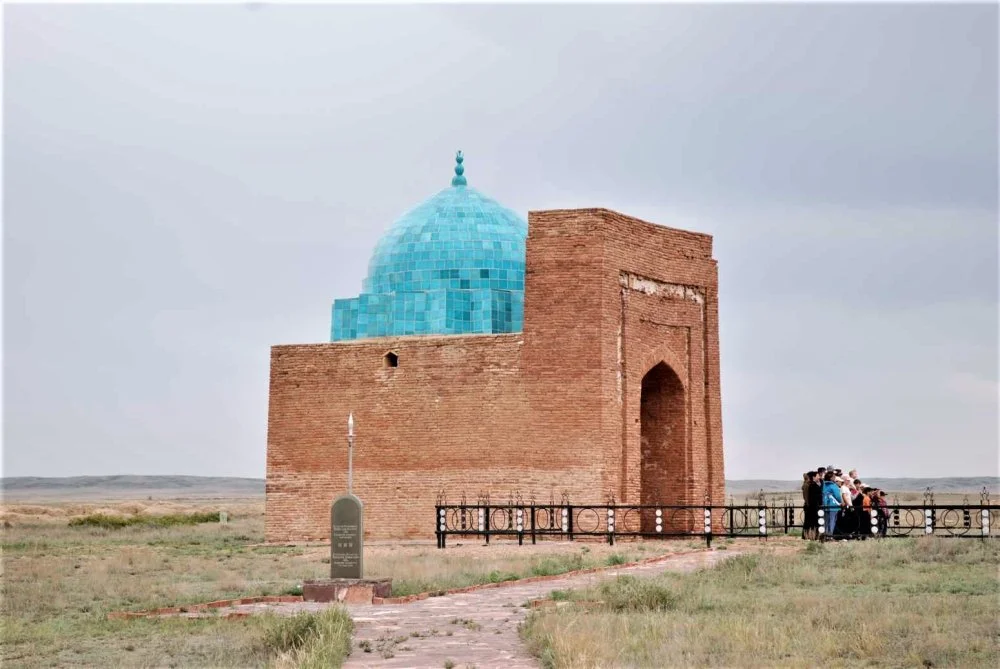
Mausoleum of Jochi Khan/Wikimedia commons
The tomb known as the Mausoleum of Jochi Khan, located in the Ulutau region, is not necessarily related to him. Modern researchers date the burials in this mausoleum to the fourteenth century, when the ruling elite of the Ulus had already converted to Islam. Jochi may have ordered that his burial place be kept secret as was customary in his lineage. For example, Chinggis Khan, who would die a little later than his son, ordered that thousands of horses be driven around his burial site to destroy any trace of it.
The conquests of Batu, son of Jochi (died 1255), gave the Ulus vast territories in the northwest: the Volga region, most of ancient Russia, including Kyiv and Vladimir (as well as a small, little-known fortress on the outskirts of Vladimir’s lands, Moscow), the Caucasus, the Crimea, and the northern Black Sea coast as far as the Danube. In the east, the power of the Jochi descendants extended to southern Siberia. And although the Ulus of Jochi under Batu was part of the Mongol Empire, it is Batu who can be considered the founder of the future Golden Horde.

Batu Khan (c.1207-55), Mongol ruler, 1871 (engraving). Batou, illustration from 'The Travels of Marco Polo' by Marco Polo and Rustichello da Pisa, translated by Henry Yule, first published 1871)/Wikimedia Commons
ORIGIN OF THE NAME
Historians traditionally call the Ulus of Jochi (in Mongolian ‘Zuchiyn Uls’) the Golden Horde. This name appeared late in history and is found in Russian sources by only about the middle of the sixteenth century. The state of Jochi’s heirs had disintegrated a hundred years earlier. However, the term ‘Golden Horde’ still has a connection with the realities of the thirteenth and fourteenth centuries.
A ‘horde’ is a common term in Turkic languages for a camp or the headquarters of a tribe and its leader. Exactly when the Horde becomes golden is not known. The Italian Plano Carpini, who was the first European to see Batu (1246), reported that his tents were ‘made of linen cloth that had once belonged to the king of Hungary’. But in the fourteenth century, the famous Arab traveler Ibn Battuta had already described in admiring tones the ‘golden tent’ of Özbeg Khan, ‘decorated and strange’. He wrote: ‘It is made of wooden poles covered with golden leaves. In the center is a wooden throne covered with gilded leaves; its legs are of pure silver, and its top is studded with precious stones.’ This throne was occupied by the khan himself and his four favorite wives, two on each side. In other words, the golden throne of Özbeg Khan looked more like a sofa or a bench than an armchair and could comfortably seat five people.
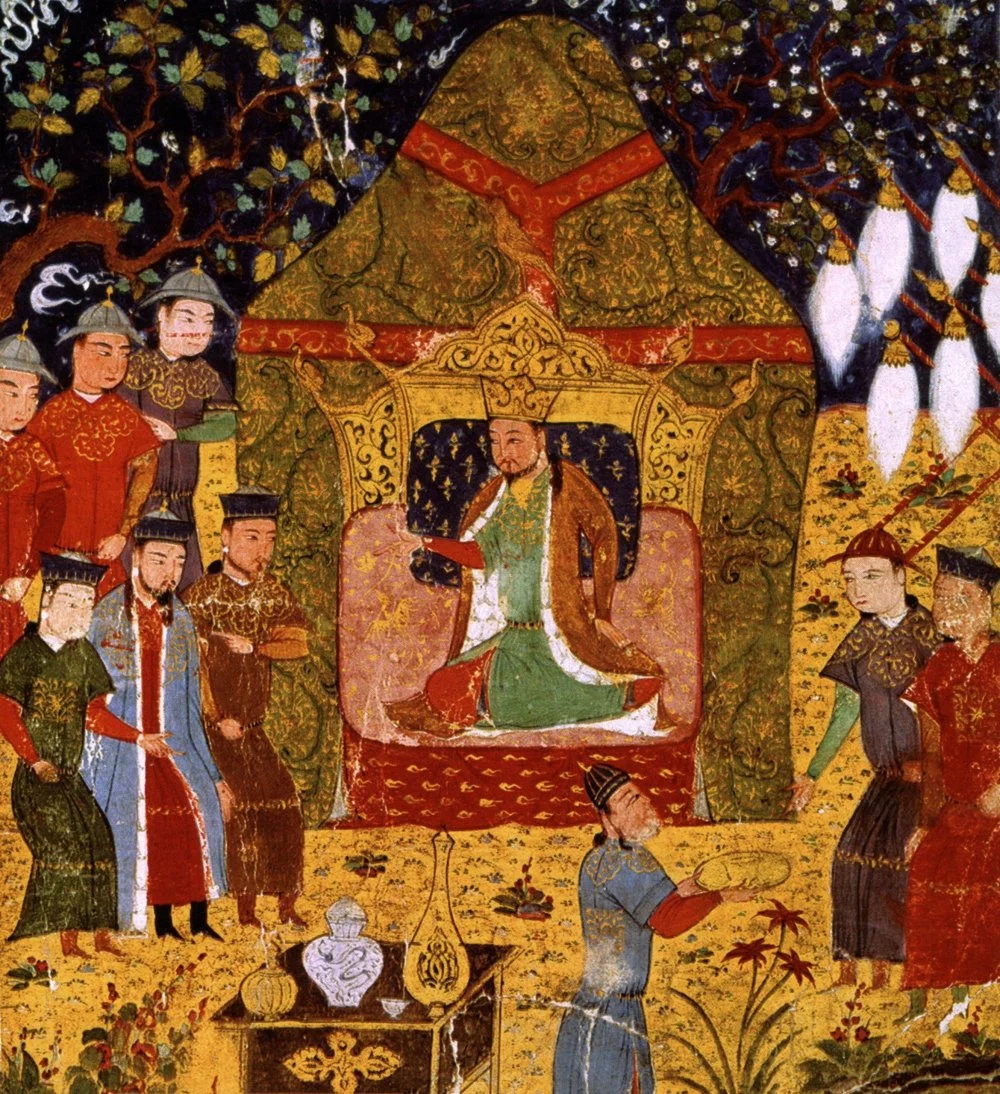
Genghis Khan is on the throne. Persian miniature of the 15th century/Wikimedia commons
Note the very honorable position of the khan’s wives in the Golden Horde, which amazed many contemporaries in both the Muslim East and the Christian West. Ibn Battuta wrote: ‘In this land, I have seen miracles of the great honor in which they hold women. They are held in higher esteem than men.’ Indeed, far from the stereotype of Oriental beauties confined to the harem or hidden under the burqa, the women of the Horde participated in state ceremonies and affairs. They played an independent, important, and sometimes fatal role in the history of this state, which we will discuss momentarily.
‘Golden’ was not the only color that historians of that time associated with Jochi’s heirs. According to Mongol military tradition, the Ulus of Jochi was divided into left and right wings, each with its own color: Ak Orda (the White Horde) and Kök Orda (the Blue Horde). Traditionally, Ak Orda was considered the left or the eastern wing of Ulus of Jochi, which was led by Jochi’s eldest son and Batu’s brother, Orda Ejeni
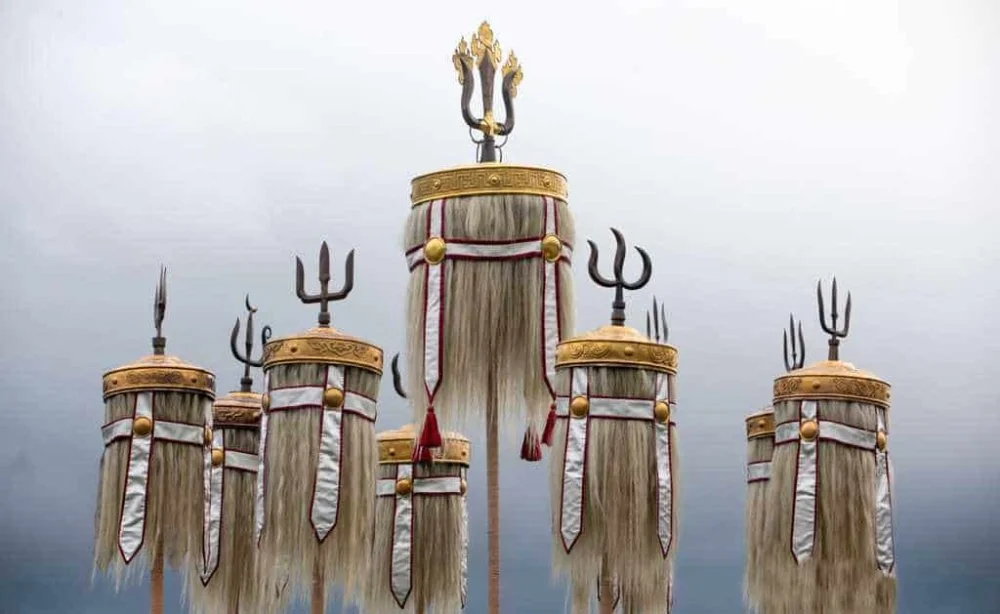
The ceremony of honoring the Nine White Bunchuks/from open access
Unlike Batu, Orda Ichen was not ambitious and voluntarily ceded supremacy to his younger brother. The khans were chosen from among Orda Ichen’s descendants at their own kurultai (as the Mongols and Turks called their assemblies), and Batu's heirs did not interfere in their affairs in any way. However, they could count on Ak Orda’s participation in all-horde campaigns. Orda Ichen’s army numbered around 50,000 blades and was a solid military force.
The border between the wings ran roughly along the Yaik River (Ural). Thus, the White Horde covered most of the territory of modern Kazakhstan, and its capital was located first at Lake Balkhash and then in the city of Sighnaq on the Syr Darya. All these factors contributed to naming the residence of the President of the Republic of Kazakhstan ‘Akorda’.

Kazakbay Azhibekuly "Kaganat", " Kurultai/e-history. kz
Either way, the Golden Horde was officially called the Ulus of Jochi or the Great Ulus, which by the mid-thirteenth century had become the most extensive empire in Europe at the time. Foreign contemporaries called it either simply ‘Horde’ or ‘Dasht-i Kipchak’, or the Kipchak or Cumanian Steppe, by the name of the tribe long and well known to Europeans. The name ‘Tataria’, after the names of some Turkic tribes, was also in use. In the West, Tataria was often identified with the mythological ‘Tartary’. The ancient Greeks called their hell Tartarus, and there is nothing surprising about this ominous allegory. The reputation of the fierce conquerors who almost invaded Western Europe was frightening.

A 1562 map. Russiae, Moscoviae et Tartariae Descriptio by Abraham Ortelius, Antwerp, 1592/Wikimedia Commons
WHAT BATU LOOKED LIKE
We know very little about Batu, the creator of this powerful state. Plano Carpini reports that he and his companions were told before the audience to ‘pass between two fires … so that if you intend any evil against our Lord or accidentally bring poison, the fire will take away all evil.’ Travelers were also strictly forbidden to step on the threshold of the tent, an offence punishable by death.
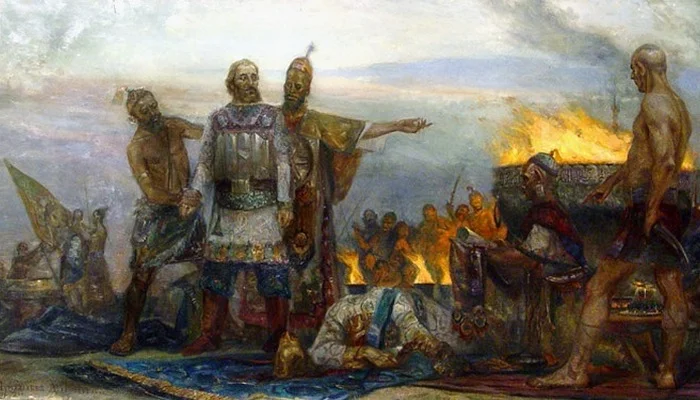
The Martyrdom of Prince Mikhail and Boyar Theodore of Chernigov Author: Kostylev Dmitry. 1999/artnow.ru
After such preparations for meeting the great man, we are entitled to expect vivid details of his appearance and habits. But no! Either the frightened Plano Carpini didn't manage to look at the formidable khan closely or he was disappointed. He only notices that when Batu or other princes drink, some people sing or ‘play the guitar’ for them. And when the khan rides, ‘a sunshade or a tent on a spear is always carried over his head’. The rest of his descriptions are rather banal: ‘Batu is very kind to his people, but still inspires them with a strong fear’ and ‘he is cruel, wily, and cunning in battle’. It begs the question: was it worth traveling such a long way to meet the khan only to make such remarks?
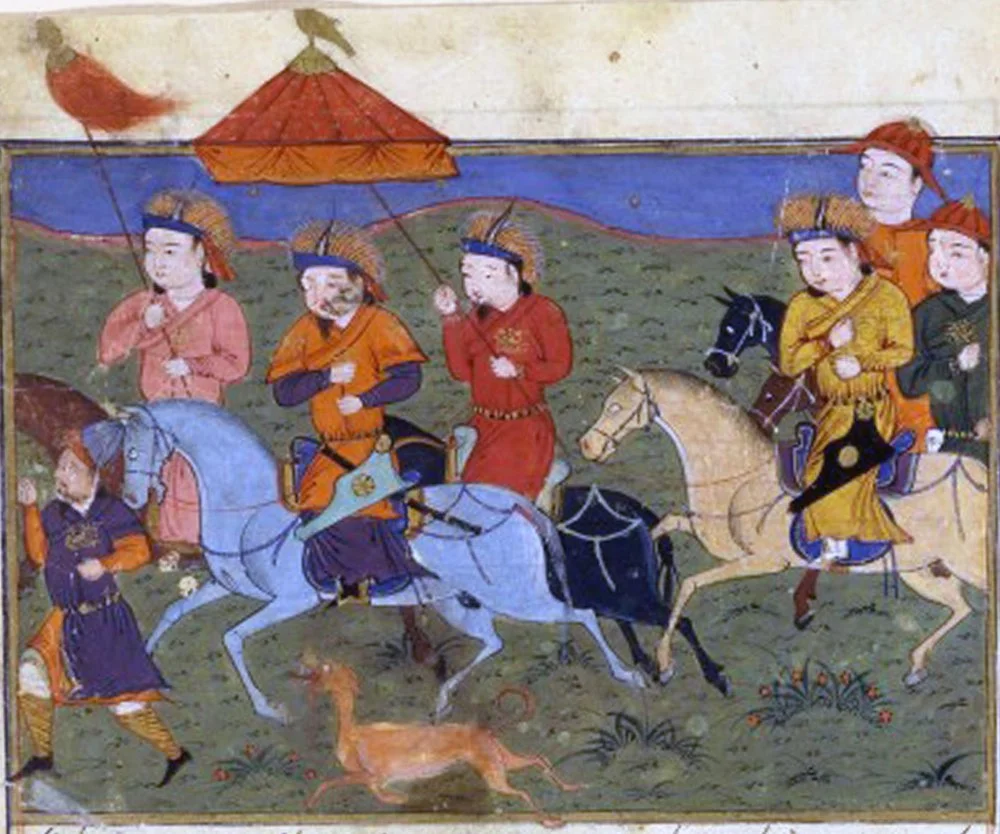
Hulagu and his army. Jami' al-tawarikh, Rashid al-Din/Alamy
Another traveler, Guillaume de Rubrouck, was a bit more observant. Batu sat on a wide, bed-like, gilded throne with his ‘mistress’, who was probably his first wife, Boraqchin (remember that name as it will come up later). The other wives and men sat ‘here and there’. Rubrouck and Batu looked at each other for a while. ‘In stature,’ Rubruck reported, ‘he seemed to me to resemble Jean Guillaume de Beaumont, may his soul rest in peace. Batu's face was at the time covered with reddish spots.’ Unfortunately, we have no information about the appearance of the mentioned Jean Guillaume de Beaumont, a crusader and knight of the French king Louis IX.5
Either a short man or a giant with a face covered in red spots—that's all we know about the appearance of the founder of the largest state of medieval Europe.

Alexander Nevsky asks Batu Khan to spare Rus'. The end of the XIX century/ Russian State Library
AN EMPIRE IS NOT EASY
In popular books, we read that Chinggis Khan supposedly dreamed that a virgin with a golden bowl on her head could walk through his empire from sea to sea without fearing for the bowl or her innocence. Unfortunately, this poetic image has nothing to do with Chinggis Khan. It is a late fiction, although it expresses quite accurately the idea of an empire in which there were no borders between nations, there were uniform laws, and everyone could enjoy peace and tranquility.
However bloody the conquests were, we will see that the Mongols, including the rulers of the Ulus of Jochi, were very careful about the security of trade routes. From the thirteenth century, the Jochids became the main partners of the Genoese republic in Italy. This bizarre alliance of the nomadic steppe and urban Italy, khans and democracy, was the backbone of the Eurasian economy of the late Middle Ages.
In ancient times, it was much easier to create an empire than to maintain it. For example, the Ulus of Jochi, itself the largest state in Europe, was only one of the provinces of the vast Mongol Empire, with Karakorum as its capital. But in the absence of telephones and email, not to mention airplanes, trains, and automobiles, it was extremely difficult to manage such an empire. The distances between its parts were simply incomprehensible.

View of Karakorum Palace (Qaraqorum) with the Fountain Silver Tree. Engraving from “History of Catholic Missions” by Henrion 1846©The Holbarn Archive / Bridgeman Images
For example, Guillaume de Rubrouck traveled from the Mongolian capital of Karakorum to Batu’s headquarters on the Volga in the thirteenth century. The journey took him two months and ten days. Rubrouck admits that he did not see a city or a trace of a building along the way. He only came across a few graves and a village once. He repeatedly reports starvation and the threat of death from hunger and thirst. However, by the standards of the time, Rubrouck traveled at a kind of jet speed.
Another traveler who made this journey a little earlier, Plano Carpini, says that the road took him the whole winter, from mid-November to the beginning of May, more than five months, and that he usually slept in the snow in the desert, ‘where there were no trees, but a flat field; sometimes we could only dig a place with our feet’. In windy weather, the snow often covered the travelers completely. In such circumstances, how could there be any regular administration of the empire?
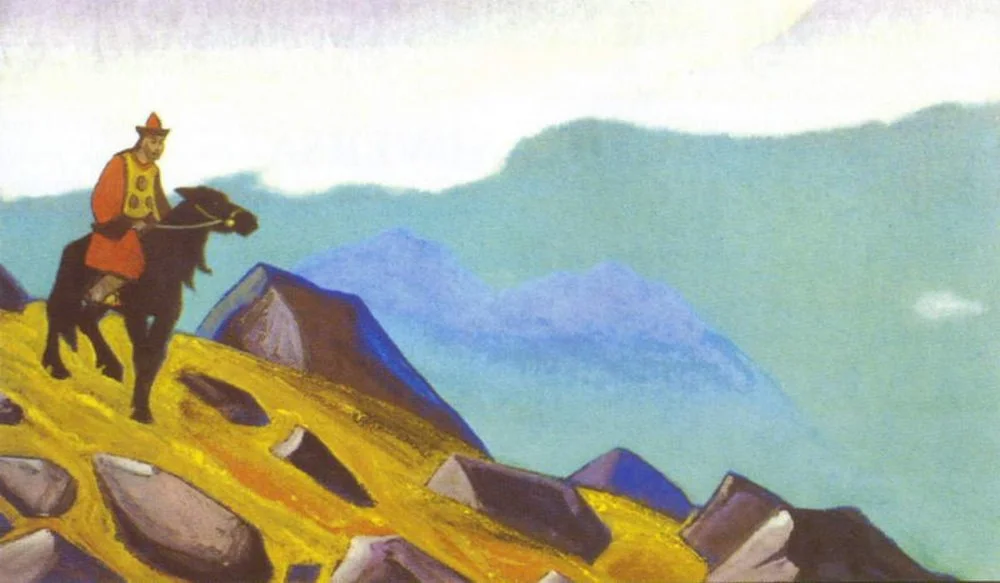
Genghis Khan by Nicholas Roerich. 1945/Alamy
The Mongols, of course, realized that distance was the weakest link in the empire. So from the very beginning, they set out to build an extensive system of postal stations from China to Anatolia every 30 to 50 kilometers. According to Marco Polo,6

Richard Caton Woodville junior. A Mongol Courier carrying the Chinese Mail across the Gobi Desert / bridgemanimages.com
Of course, the Mongol Empire was not built as a centralized state but as a multi-component empire with great autonomy for each ulus. At first, Chinggis Khan’s children and grandchildren played a game of ‘Great Empire’, but soon they began to quarrel and even fight among themselves. The Jochids, who had supported the wrong claimant to the main throne, lost, but this helped them to isolate themselves in their own very large empire. Thus, by the 1260s, the Golden Horde was quite sovereign.

Mongolia by Nicholas Roerich. 1938/Музей Рерихов
From the Mongols’ point of view, the Kazakh steppe, thanks to its vast pastures, was the best part of the empire. But any non-Mongol would say that these lands were poor and desolate, especially compared to the other ulus that were urbanized and densely populated. Nevertheless, the Ulus of Jochi proved to be the most resilient and outlived the ulus of the conqueror's other children and grandchildren including the Ulus of Chagatai, which encompassed the ancient and rich agricultural oases of Central Asia; the Ulus of Hülegü, which conquered Persia, the Middle East, parts of Asia Minor, Transcaucasia, and Afghanistan; and the Ulus of Tolui, which conquered China and proclaimed the Yuan Empire. All these states had ceased to exist by the middle of the fourteenth century, but the Jochids were at the height of their power during this period.
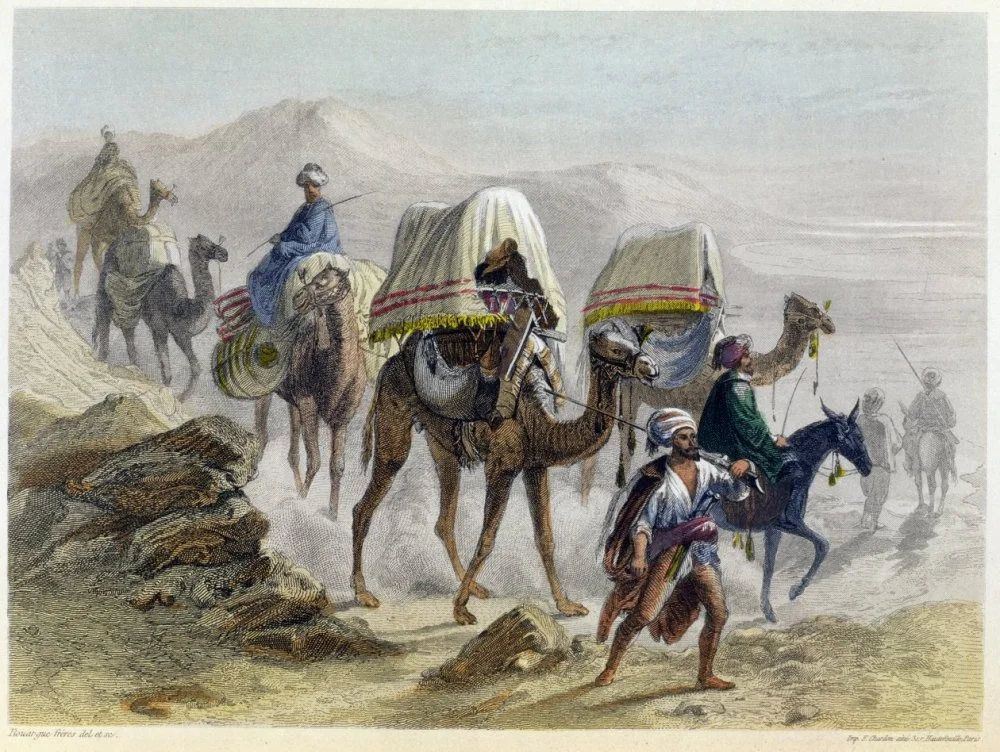
The Camel Train, from 'Constantinople and the Black Sea', engraved by the Rouergue brothers, 1855/Wikimedia Commons
This kind of stability is no miracle to achieve. The poor and sparsely populated Ulus of Jochi had no powerful local elites, no influential bureaucracy with ancient traditions, and the Khans remained the richest and strongest players for a long time. As the central and local elites grew and the Khan family multiplied, in the second half of the fourteenth century, the Ulus of Jochi would also fall into an era of countless coups and infighting, which Russian sources aptly called the Great Confusion. Worn out by internal strife, the Golden Horde was unable to withstand the attack of Timur (1336–1405), and by the fifteenth century, it no longer existed. New, more compact khanates rose on its ruins, including the Kazakh Khanate (1465).
THE COUNTRY AND ITS POPULATION
At its peak in the fourteenth century, it is believed that the population of the Golden Horde was about 15 million people, more than any European country at the time. However, as in the Mongol Empire, the population density was extremely low. Guillaume de Rubrouck reports that after landing at Sudak in the Crimea, he set out for the Volga. The journey took him two months, and ‘we never stayed in a house or in a tent, but always in the open air or under our wagons, and we did not see a village or even a building’. The only thing that could catch the traveler’s eye were the Cuman burial mounds.
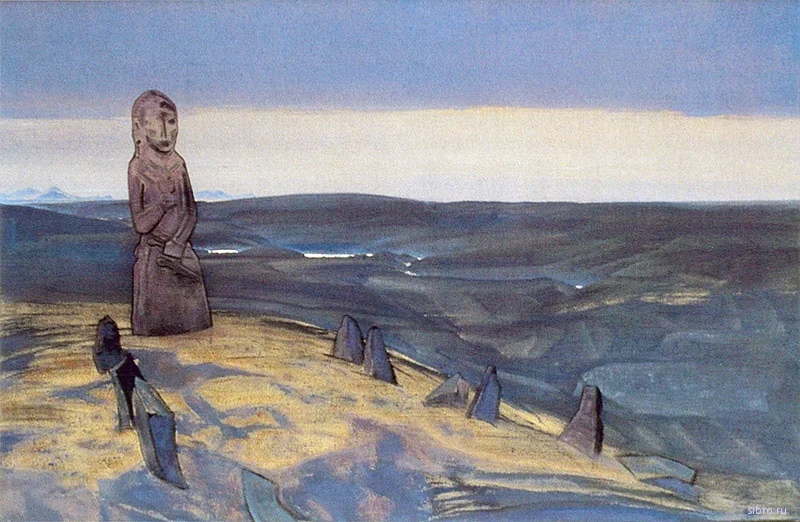
N.K. Roerich. The Guardian of the desert. 1941 From the collection of Y.N. Roerich The location is unknown
The desolation and the monotony of the landscape of this vast country was the refrain of many travelers’ notes, especially those who came from Western Europe, where mountains and valleys quickly replaced each other, where the presence of man and his hard work was everywhere, where crowded walled cities merged with villages and then again with cities, where even steep cliffs were terraced with olive trees and vineyards. In the steppe, everything was different. Here, it was as if the same place moved with the traveler for days, weeks, months, nothing attracted their attention or dispelled the boredom of the road.
But it wasn’t just about entertainment for idle travelers. In the West, the diversity of landscapes created natural boundaries for a multitude of relatively small states that were constantly competing for revenue or people. And for a long time, none of them was wealthy enough to survive without financial subsidies from their subjects, who were a force to be reckoned with. The high population density stimulated competition at the grassroots level and, as a result, intensive innovative development. This contributed to the emergence of rather complex societies that learned to reconcile conflicting interests and to defend themselves against arbitrary rules by means of law, community solidarity, sabotage, or even armed resistance.
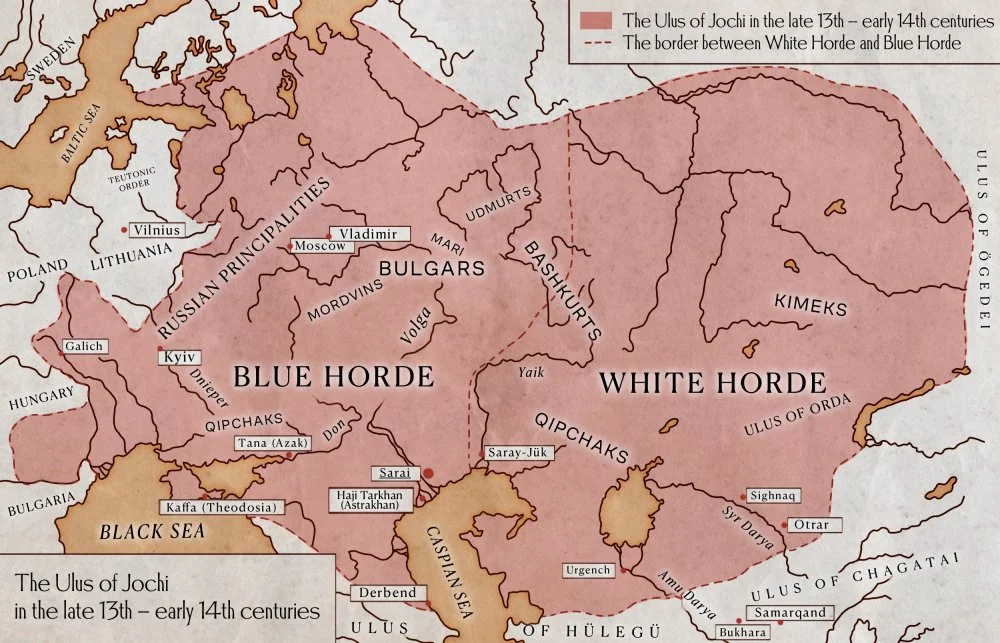
Qalam
Scattered over vast areas, the sparse population of the steppes was content with undertaking extensive agriculture and, most importantly, was completely defenseless against the military might of their ruler. In addition, the ruler was not particularly dependent on his people since he received a significant portion of his income in the form of booty or tribute. However, the despotism of this part of Asia should not be exaggerated. The power here was rather flickering. It was much farther away, if only because of the vast distances involved, than the power in the West, which literally dominated every village in the form of a castle, monastery, or city. The steppe dweller most likely considered himself a completely free man. Therefore, he had no reliable immunity to violence when power suddenly appeared out of nowhere in a cloud of sand and dust that obscured both the sky and sun.

Nicholas Roerich. The Polovtsian camp. 1908/The State Tretyakov Gallery
The Mongol elite of the Golden Horde in the thirteenth century remained Tengrian, but the rulers adhered to the traditions of Chinggis Khan, who was tolerant and respectful of all religions. The reverence that the Western envoys—clerics and travellers such as Plano Carpini and Guillaume de Rubrouck—enjoyed at the court of the khans is a vivid confirmation of this. Note that they looked like poor wanderers. Both travelers were Franciscan monks who usually wore a robe of gray sackcloth belted with a rope and sandals. The khans and nobles were not at all embarrassed by their appearance.
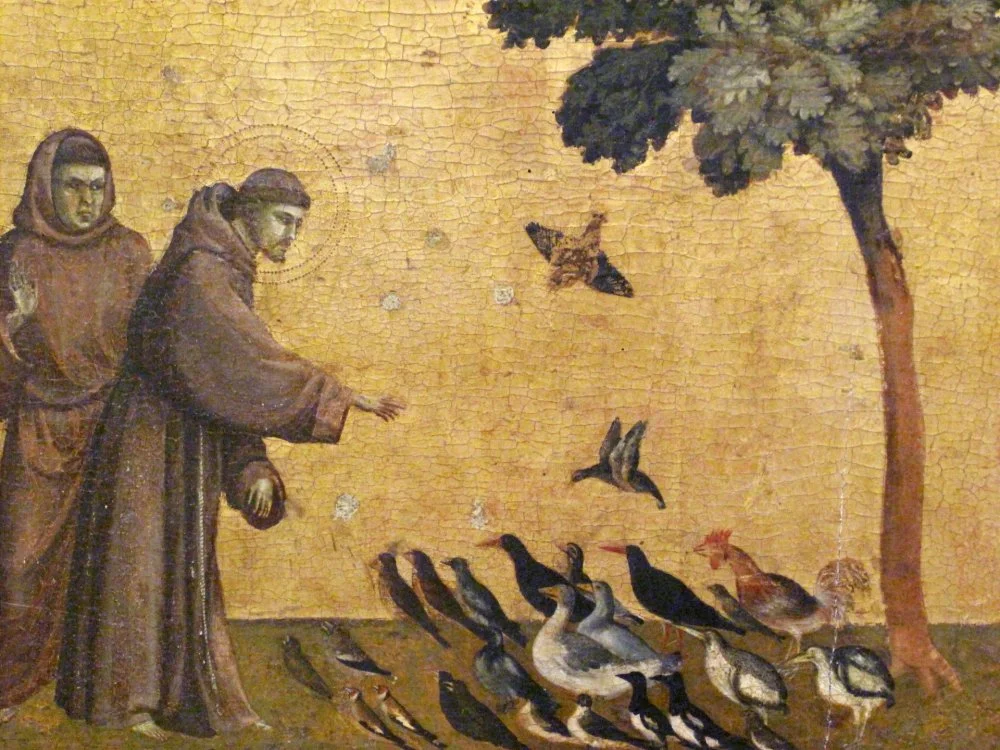
Relatively few Mongols migrated to the Ulus of Jochi. Rashīd al-Dīn7

Tengri/from open access
STATE SYSTEM
The power of the Jochids rested entirely on the almost divine authority of Chinggis Khan, from whom his descendants—the altan urag or golden clan—inherited the patronage of the higher powers: Heaven (Tengri) and Earth (Etugen). The Golden Horde in its entirety was considered the property of the Jochi family and was divided among his fourteen children. However, the supreme rights of ownership and distribution remained with the khan. He distributed yarlyks—originating from the Turkic and Mongolian word for ‘command’, a yarlyk was a letter for the entrustment of power or the use of special privileges—to his relatives and vassal rulers, such as Russian princes.
According to Mongol tradition, the country was considered an army and was divided into military districts according to the number of warriors they had to field: tümens (10,000), thousands, hundreds, and tens. The Mongol thousands became a melting pot in which many ancient ethnic groups, tribes, and clans of the steppes dissolved. Thus, completely new systems of horizontal ties and identities were formed. They were united by one thing—their worship of the heirs of Chinggis Khan, ‘born of the heavenly ray’.
Over time, these fighting structures would evolve into new tribes and clans that would see the commanders of Jochid military units as their ancestors. Relying on these tribal structures, the Jochids would retain their power even after the fall of the Golden Horde. In the Kazakh steppe, this would continue until the early nineteenth century. Kazakhstan was the last country to honor the cult of Chinggis Khan until modern times.8
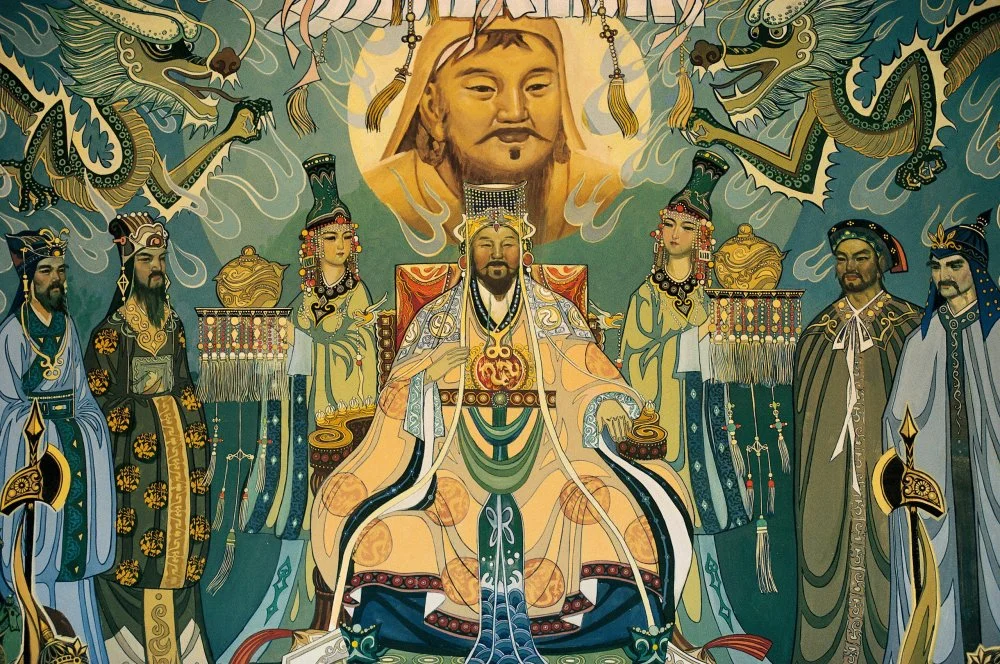
Mural with Genghis Khan, Temujin, Great Khan of the Mongol Empire, and his court, Dongsheng, Inner Mongolia, China, Asia/Alamy
The Mongol army system extended to the settled lands of the Russian principalities as well. Here, however, the Mongols resorted to an innovation that they had learned from Chinese officials. In the late 1250s, they conducted a census of the Russian population in order to correctly calculate taxes and the number of recruits. Then, Russia was similarly divided into tümens. Russian recruits were always present in military formations, but silver and various payments in kind were of primary interest to the Horde.
The khan’s council consisted of four karachi beks, headed by the eldest who was called the Beklerbek, which represented the major aristocratic clans of the Ulus. In the western part of the Horde, this council effectively replaced a more representative Mongolian body, the kurultai, although it did not disappear entirely. The Beklerbek and karachi beks served as the military ministry and headquarters of the general staff. But as administrative tasks became more complex, another administrative pyramid began to take shape.
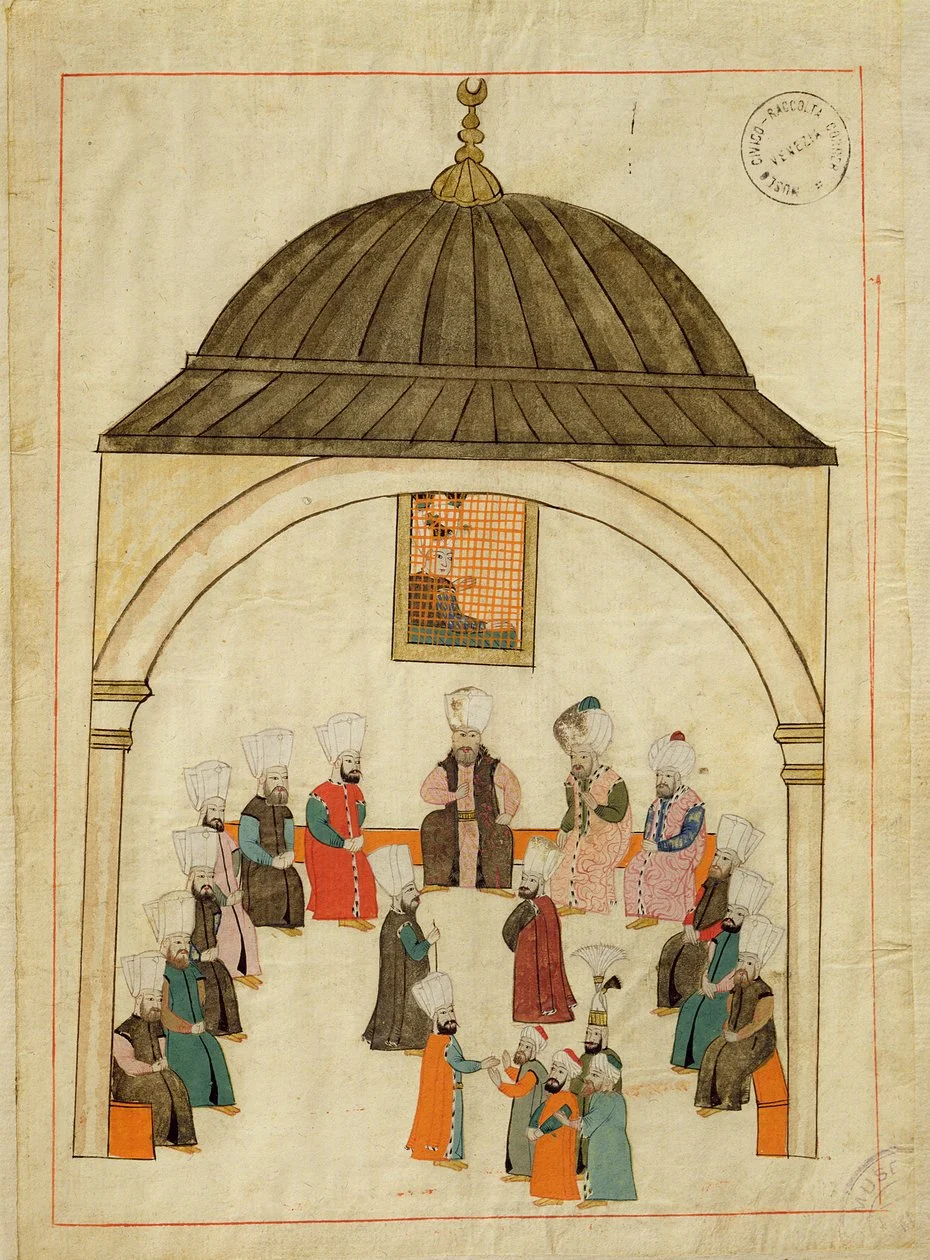
Diwan. Medieval miniature/MeisterDrucke
The success of the Mongols was due to the fighting skills of their warriors, but it was also due to their political wisdom in many ways. Lacking administrative experience, they readily adopted the state-building practices of conquered nations. They relied not only on the most advanced administrative technologies, such as census taking, but also on generously paid local officials. Talented natives from Khwarazm became the backbone of the Jochid power, forming a new apparatus and system of civil administration not related to purely military tasks. Under their influence, a vizier and a diwan, a prime minister and a government, appeared in the capital city of Sarai. Unlike the beklerbek and his karachi beks, the vizier and the diwan were in charge of peaceful affairs, developed a system of taxation and customs, and distributed revenues. Roughly speaking, they were in charge of the cities and other settled areas of the empire.
The advantage of the Muslim model of government, which the Horde inherited from Khwarazm, was its simplicity and cheapness in contrast to the cumbersome system of officials in the Chinese empire. Thus, when the Jochids realized that it was expensive and dangerous to collect taxes from the conquered population of Russia, they first gave the right to collect them to tax collectors. Then, in order not to multiply conflicts with the locals population, they delegated this troublesome business to the local princes. People of the same community, especially princes and commoners, find it easier to come to an agreement, and there are no expenses. At first, the system worked perfectly. In the long run, however, it allowed a Moscow prince to create his own empire. But that is another story.
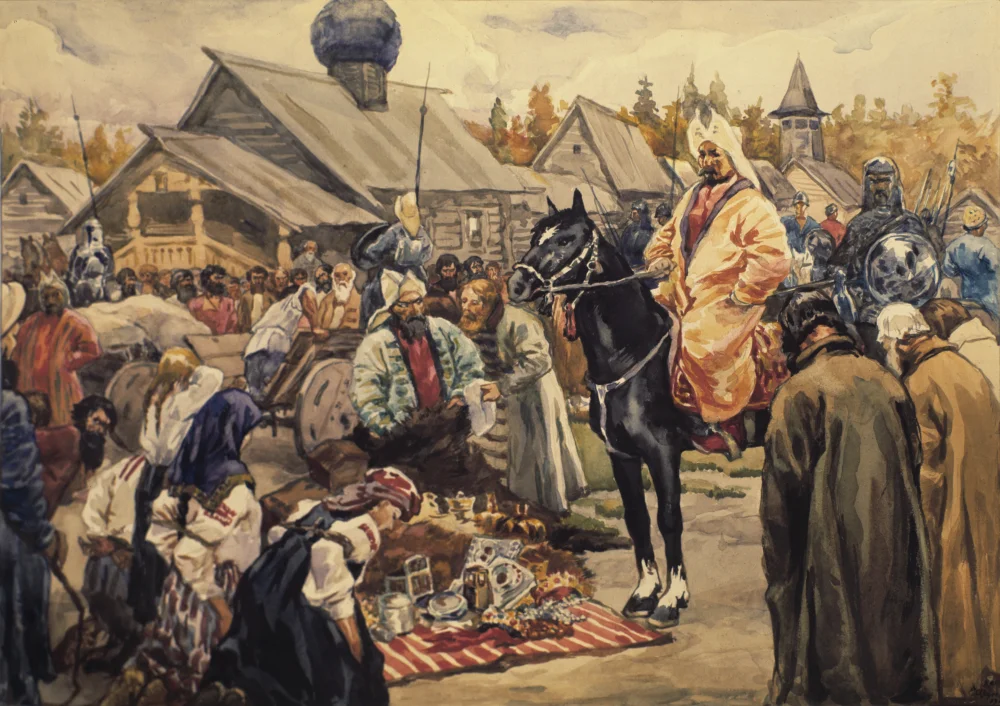
S. V. Ivanov. Baskaki. 1909. Reproduction/RIA Novosti
NOMADIC CITIES
Compared to China or Persia, the Ulus of Jochi did not have many cities. The conquerors stubbornly maintained their traditional nomadic lifestyle. In both the east and the west, the Horde, including the khan's family, traveled north each spring for summer pastures and retreated south for the winter. The eastern wing spent the summer in the northern steppes of Kazakhstan and the winter in the Syr Darya basin. The western wing roamed in the northern part of the ‘Wild Fields’ and in the former territory Volga Bulgaria.i
The sight of nomadic peoples and their rulers amazed foreigners. For example, Rubrouck tells us that the people of the Horde loaded up their houses—tents or yurts—on wagons, each of which was pulled by twenty-two bulls. The axle of such a wagon looked like the mast of a ship. They carried household goods and treasures in special chests attached to camel-drawn carts. A rich Mongol might have had 100 or 200 such chest carts. Batu Khan alone had twenty-six wives, and each of them had a large yurt, not counting small ones for domestic servants. Each yurt was followed by another 200 wagons with all sorts of things in chests. Such a caravan would have stretched beyond the horizon.
When he arrived at Batu’s headquarters on the Volga, Rubrouck admits that he ‘lost his nerve’. In front of him were many tents, surrounded by different peoples, three or four ‘leagues’ long. This French measure usually corresponded to the distance a traveler could cover in an hour on foot. If so, then Batu’s nomadic headquarters stretched for about 15 to 20 kilometers.
Even after eighty years, nothing had changed. Thus Ibn Battuta, whom we already know, observed the movement of the Horde under Uzbek Khan, when the country was at the height of its power: ‘We saw a great city moving with its inhabitants; there were mosques and bazaars, and the smoke from the kitchens wafted through the air: they were cooking food as they went, and horses were pulling arbas [carts] with them. When they arrive at the place where they will rest, they take the tents from the arbas and put them on the ground because they are easy to carry. They organize mosques and benches in the same way.’
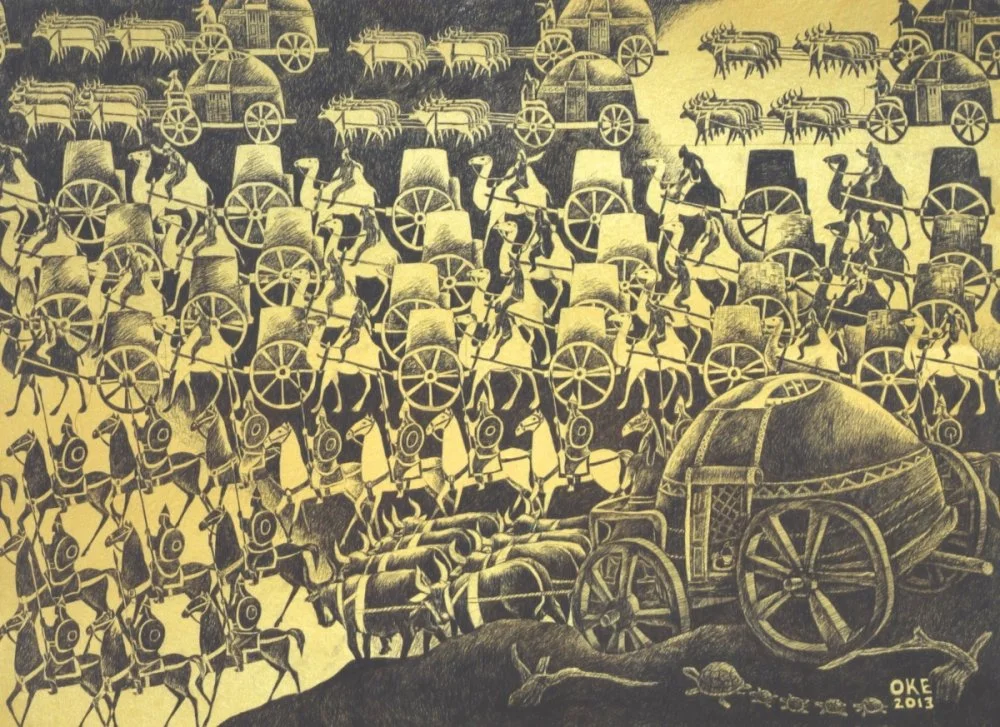
Nomads/From Open access
A STEPPE METROPOLIS
However, the creation of a large state was impossible without settled cities, where the administration of the empire would be located, where tribute from conquered regions would be brought in, and where caravans of merchants, vassals, and diplomats could arrive. The most urbanized areas of the Horde were Khwarazm, Moldavia, Crimea, and Volga Bulgaria, not to mention the Russian principalities. Urban civilization continued to develop in these places. but new cities also appeared in the steppes, especially along the main trade routes. In total, according to archeologists, about 110 urban settlements are known in the Ulus of Jochi. The most important of them was, of course, the capital of the empire.
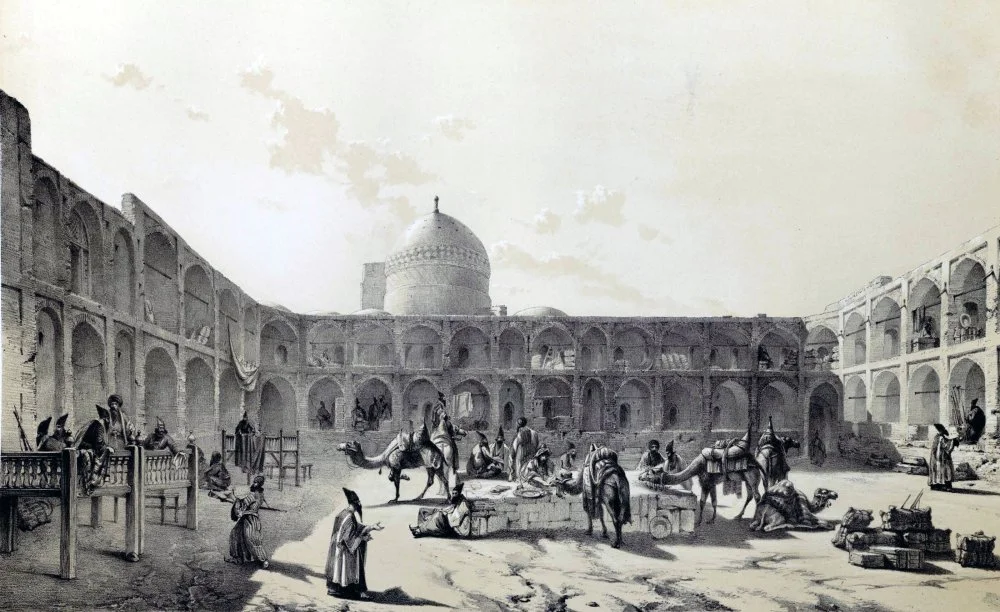
A caravanserai in Isfahan by Eugène Flandin © public domain
At first, Batu was satisfied with Bolgar, the former capital of the defeated Volga Bulgaria in modern Tatarstan. Then he moved to the lower Volga and founded Sarāy-i Bātū in 1254. Historians disagree about the fate of Sarāy-i Bātū. Some believe that Batu's half-brother Khan Berke (1256–66) built a new residence, Sarāy al-Maḥrūsah (God-guarded palace) or simply Sarāy-i Barka (the Sarai of Berke). Others believe that it is the same city just with a new palace. It is believed to be the ancient settlement of Selitrennoye in the Astrakhan region.
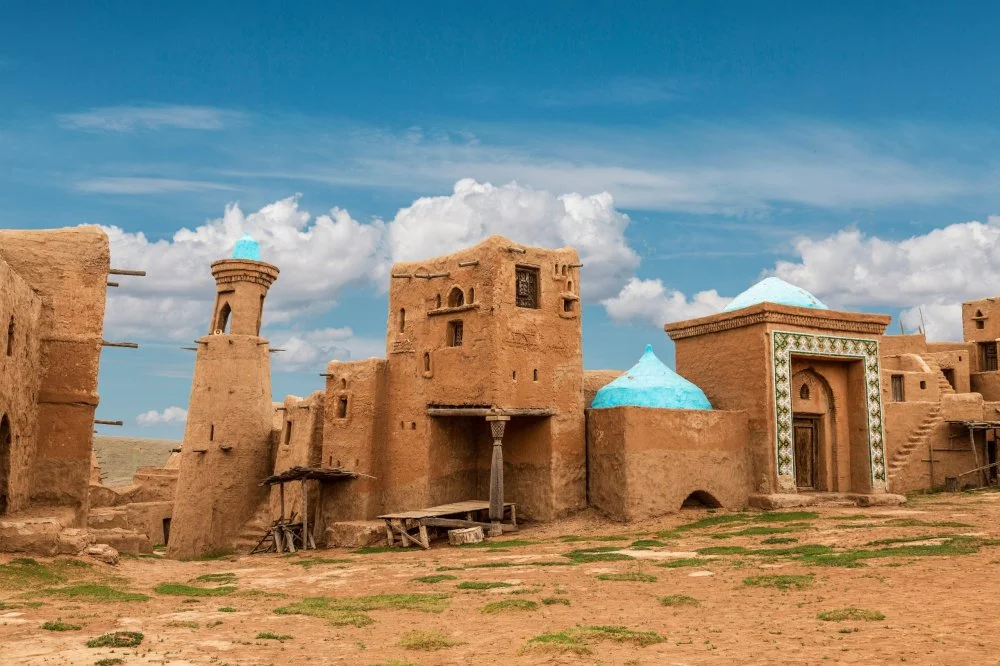
Panorama of Sarai-Batu. Scenery of the Medieval city, the capital of the Golden Horde. Stylization. Astrakhan region. Russia/Shutterstock
The city became known as Sarai and was soon one of the largest metropolises in both Asia and Europe. It is believed to have surpassed both Constantinople and Paris. Historians estimate that about 100,000 people may have lived there. Ibn Battuta, who knew a lot about cities, calls Sarai ‘one of the most beautiful cities, which reached an extraordinary size, on a flat land, crowded with people, with beautiful bazaars and wide streets’. Apparently, the size of the city really shocked the former traveler because Ibn Battuta describes in detail how he set out from one end of the city in the morning for the other and did not reach it until noon. After praying and eating, he returned home at sunset. Ibn Battuta marveled, ‘It is an unbroken line of houses, with no empty spaces and no gardens.’ One might wonder, though, what he had against gardens!

Jean-Léon Gérôme – View Of Cairo/Private Collection / bridgemanimages.com
He counted thirteen mosques in the city and found many ethnic communities: Mongolians, Alans, Cumans, Circassians, Russians, and Byzantines. It is known that there was at least one Christian temple in the city. And in 1261, Khan Berke, although he was the first Muslim on the throne of the Horde, authorized the establishment of an Orthodox diocese in Sarai. Each nation, according to Ibn Battuta, lived separately and had its own bazaars. Merchants from Iraq, Egypt, and Syria settled in their own area, surrounded by a wall to protect their goods such as precious fabrics, carpets, spices, and jewelry.
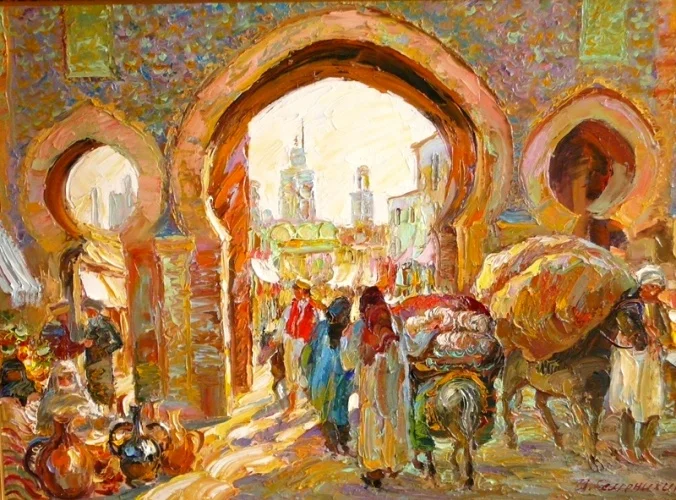
Semenikhin Igor / From the series "Oriental Bazaar" 2007/artlib.ru
The palace of the khan, according to Ibn Battuta, was called Altuntash, which he translates as ‘golden head’, another golden altyn (coin) in the piggy bank of the myth of the Golden Horde. In fact, it was not a head, but a stone. If Ibn Battuta's error was merely in translation and he actually referred to a 'golden head', Altynbash, then it's reasonable to assume that the palace had a gilded dome. This, along with numerous minarets and church domes, made up the unforgettable skyline of Sarai.
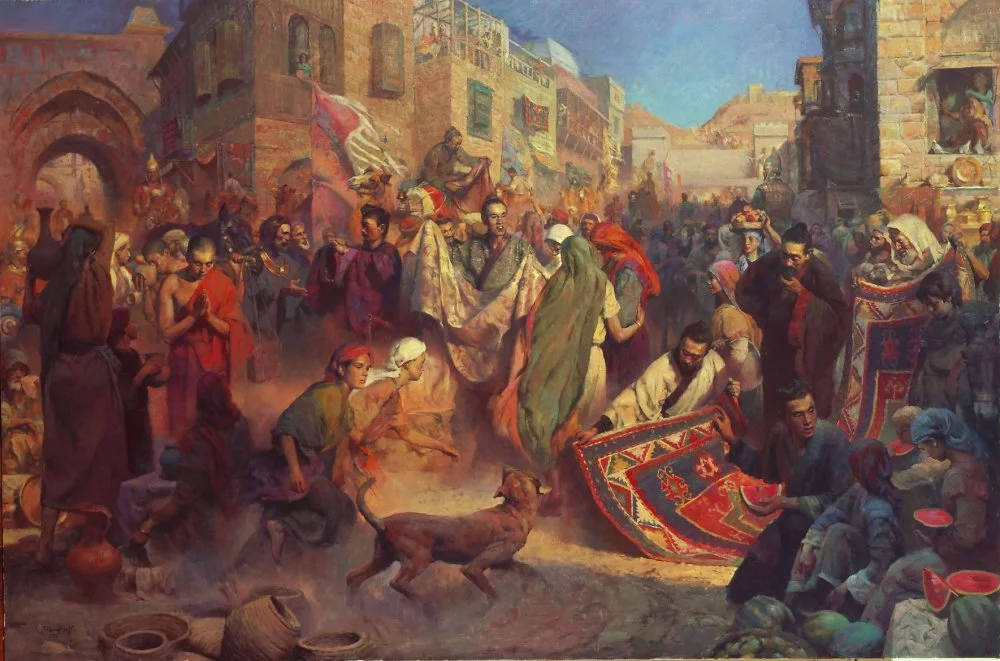
The Great Silk Road/HongNian Zhang
Archeological excavations have shown that many buildings were richly decorated with multicolored glazed tiles in the tradition of the Khorezmian masters from Urgench. Turquoise, blue, white, yellow, and sometimes gold dominated the mosaics. The city had a complex system of ditches and ponds, water supply, and sewerage. Heating worked in the palaces. However, numerous artisan slaves, driven from conquered lands, lived in miserable dugouts without any amenities.
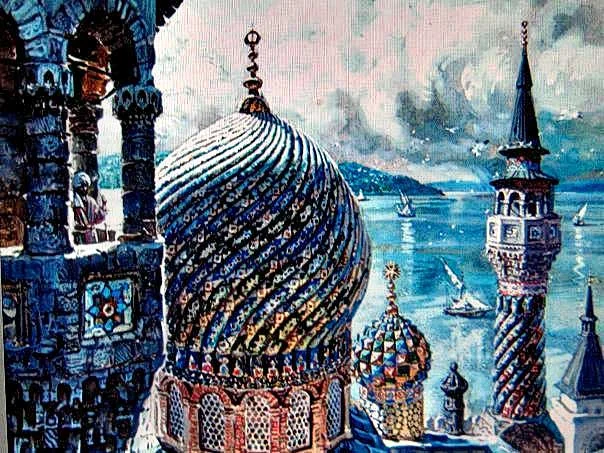
Kul Sharif Mosque. Kazan/kul-sharif.com
The most surprising thing for those times was that the city had no fortress walls. This, it must be assumed, explains the gigantic size and wide streets of Sarai. After all, who would dare to attack the city of the mighty khan of the Golden Horde? However, such carelessness would later cost the Jochid capital dearly.
Another important metropolis of the Horde, Sarayçık, or Little Sarai, was located in northwestern Kazakhstan, near the modern city of Atyrau, on the road to Khwarazm. It was a large market town on the trade route from Asia to Europe and one of the most important necropolises of the Jochids. After being defeated by Timur's troops in 1395, the city recovered and even managed to become the capital of the Nogai Horde.9

Fragments of tilework. Golden Horde, Sarai (city). Ceramics, paint over glaze, mosaic, gilding. Selitrennoe settlement, excavations of 1980s/State Historican Museum of Russia.
INCREDIBLE ATTRACTION FOR ITALY
In the 1260s, Syria, eastern Iran, and Central Asia were engulfed in almost continuous warfare between various ulus of the Mongol Empire as well as between the Ilkhansi

Bypassing the Central Asian oases and the Syrian ports was difficult but possible. The caravans would have to go not through the Persian lands to the Mediterranean, but to the north, exactly through the lands of the Ulus of Jochi, from Otrar to the cities of the Syr Darya, then Khwarazm, Mangystau (Mangyshlak), the Lower Volga region, and the ports of the Black Sea. After crossing the Bosporus and the Dardanelles, the cargoes were on their way to Western Europe.
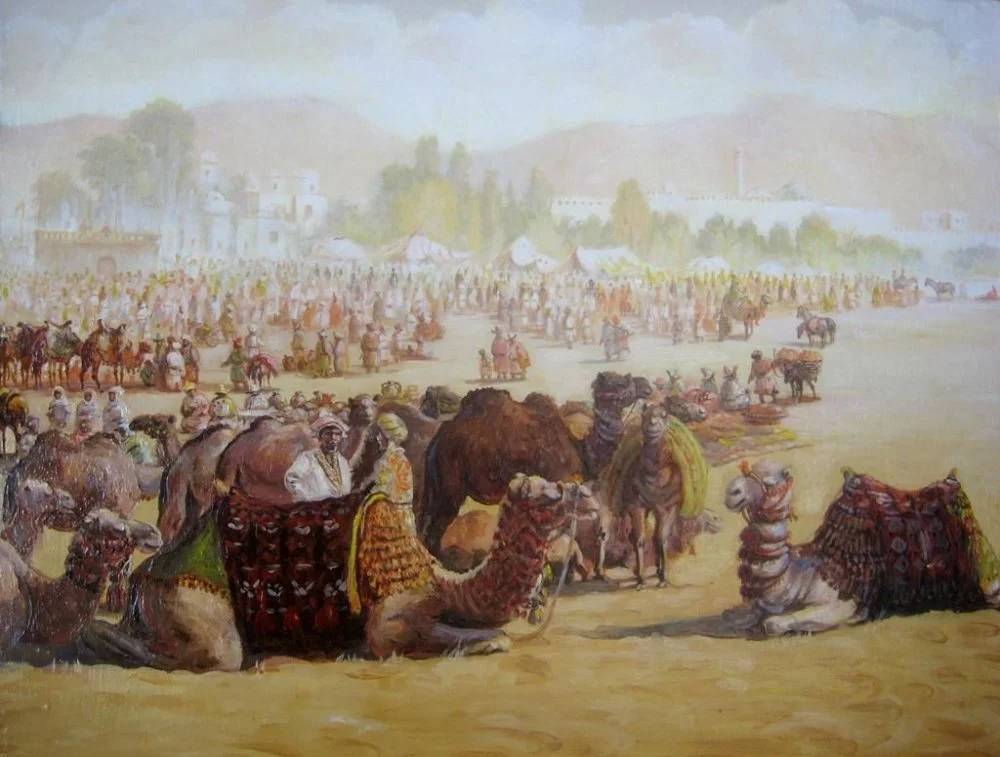
Trade caravan/from open access
At the same time, Venice, a powerful maritime power that had monopolized the entire eastern Mediterranean, was in deep trouble. Venice had been behind the Crusaders’ destruction of the Byzantine capital, Constantinople, in 1204. The Greeks, who drove out the Latins in 1261 and recaptured Constantinople, naturally decided to punish Venice, as we would say today, with sanctions. And the cruelest punishment was a ban on trade in the Black Sea, which could become an alternative to the Syrian ports. The Byzantines gladly handed over this market to Venice’s worst rival, another Italian maritime republic, Genoa, which seemed to have lost its primacy in eastern trade forever.
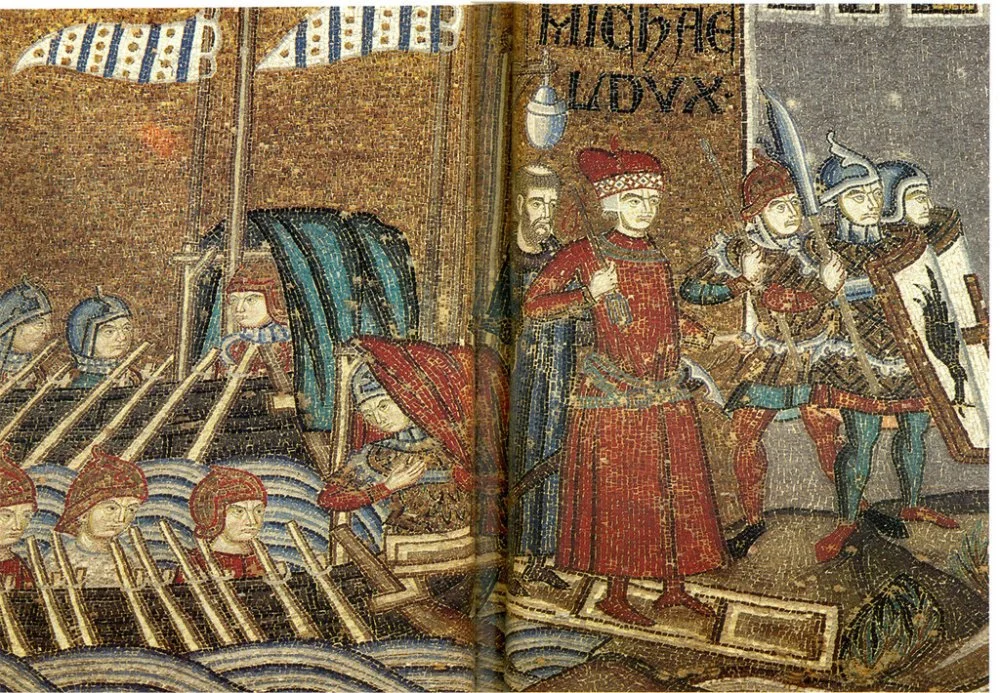
Venetian galleys on Chios. A detail of the mosaic. Venice (Early 14th century)/Wikimedia commons
And then two yearning entities met, the Jochids and Genoa. Thus, a new route of the Silk Road was created—through the Kazakh steppes to the Black Sea. In 1266, the Genoese founded their colony of Caffa (modern Feodosia) in the Crimea, which soon became the main jewel in the crown of the Jochids—if they wore crowns. At the height of its prosperity, Ibn Battuta saw in Caffa ‘200 military and cargo ships, small and large’, which is impressive even by today's standards. The traveler’s conclusion—‘This is one of the most famous ports in the world’—does not seem to be an exaggeration.
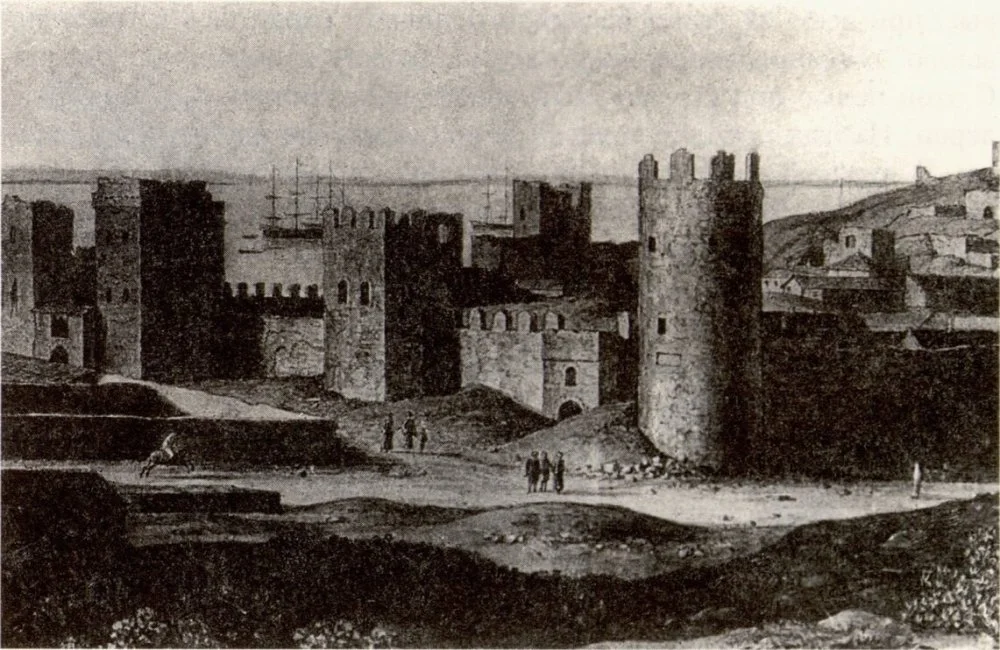
The western facade of the citadel of Kafa. Drawing by K. Kugelchen. 1820/Wikimedia Commons
Of course, Venice tried to put up resistance, but it was defeated by the Genoese in the Battle of Curzola in 1298. In this battle, Marco Polo, an important Venetian for our region, was captured by the Genoese. In the Genoese prison, suffering from idleness, he dictated the legendary stories of his travels along the Silk Road to China, without which historians would have had a hard time.
However, the Venetians did not give up, and in 1319, Uzbek Khan allowed them to establish their trading post in Tana (modern Azov), most likely so that the Genoese would not be too busy. However, another war between the Genoese and the Venetians ended with Genoa’s victory in 1381, and the Venetians were forbidden to sail to Tana for the next two years. All this would soon lose its importance when the Golden Horde was defeated by Timur.

Anonymus 16th century , The Doge of venice Bartolomeo Gradenigo with the Venetian fleet in the century of Chioggia - 1379/Alamy
But while things were going well, the khans were getting incredibly rich from the tariffs and taxes, and the Horde developed an entire industry focused on transit trade: from the network of caravanserais along the new route of the Silk Road to the wealthy trading companies— ortaks—that enjoyed the Khan's unwavering patronage in part because they delivered various overseas curiosities to the court. However, the Golden Horde did not only consume luxury goods. It supplied international markets with furs, leather, grain, salt, horses, camels, silk, brocade and cotton fabrics, precious stones, and dyes from its Central Asian possessions. And, of course, the main export was slaves.
The redirection of the main trade route from Asia to Europe from the Iranian-speaking countries to the Turkic countries, that is to the Ulus of Jochi, was another factor in the international success of the Turkic languages. In the history of Asia, the Persian Age was replaced by the Turkic Age, which, thanks to the Ottomans,11
Read the second part of the history of the Jochi Ulus here.
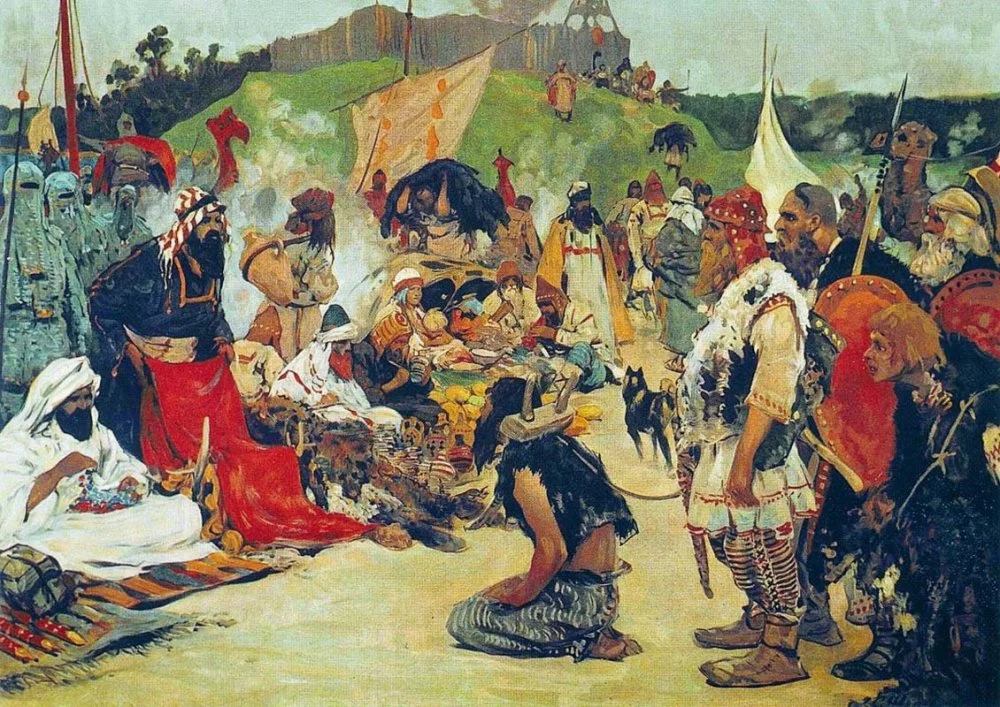
S.V. Ivanov. Trade negotiations in the country of Eastern Slavs. 1909/Wikimedia commons
